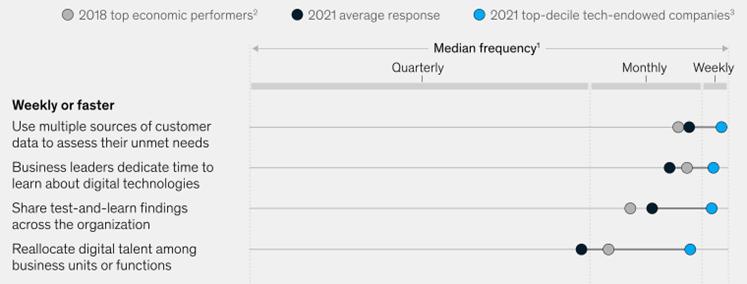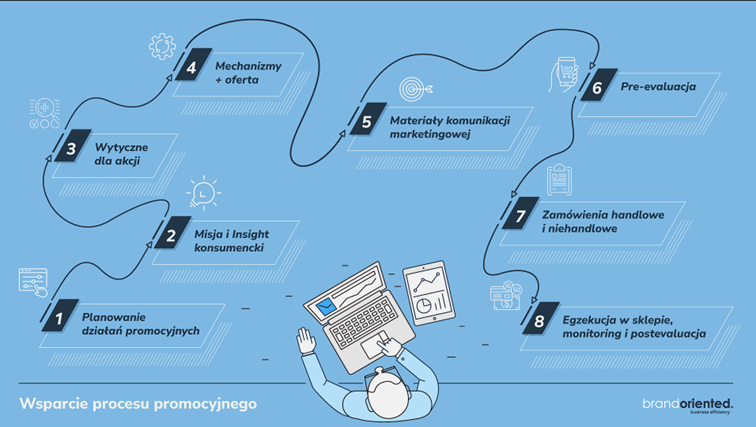
It wasn’t very long ago that at commercial businesses everyone asked the question, "What is digital transformation?". Today, it sounds different: "When will technology support the most complex process affecting the entire organisation, this process being sales promotions?". The digital promotional ecosystem created by Brand Oriented allows us to look at this area in a completely new light.
At Brand Oriented, we firmly believe in the power and the capital behind the potential of the human mind and the ability to enhance that potential – through technology. We also believe that every company has its own unique DNA, which accounts for its value and competitive advantage. This is why it is so important to fully tailor the implementation of technology solu-tions to the needs of the organisation and its unique characteristics. As the McKinsey report shows, most organisations have had to adapt their working rhythm to increasingly demanding market conditions. Appropriate allocation of human potential, as well as information sharing and proper inference, have gained in importance; and that’s irrespective of where they are actually located within the organisation. If we stick to traditional solutions, i.e. emails, PowerPoint or multi-nested Excel charts (so-called carpet reports), it is difficult to keep pace with market leaders, who are making increasingly intensive use of the latest technologies to support key processes and decisions.

Tons of data to verify – and all aboard
The most complex and key business process in retail is the promotional process. On the one hand, it is a recurring cycle in a familiar rhythm. On the other hand, it is related to all depart-ments and teams, i.e. marketing, category management, sales, logistics, sourcing, quality, merchandising, master data, trade promotion teams, or insight, BI. And all this is done so that the activities translate into consumer needs as shown in the infographic below.

The category manager always plays a critical role in this process, as it is the category manager who selects the products for this type of action. Regardless of how many products the category manager submits for promotion, there are usually around 250-500 parameters associated with each such product in terms of logistics, pricing, basic data, etc. The category manager is responsible for majority of these parameters.
If we consider that promotions are organised every fortnight (on average), and 600-2,000 products get involved, we arrive at a scale of several hundred thousand parameters that must be taken into account, confirmed, or modified for the commercial activities. Besides, we have to add the whole layer associated with working on a common basis of promotional products, carried at the same time by a dozen managers in consultation with, among others, marketing department. And there are a dozen such promotions being developed at the same time by the team – each at a different stage of preparation. This is the moment when Effiana comes to our aid.
Benefits for teams and company finance
Effiana is a one-stop digital working ecosystem for the entire promotional process that, on the one hand, integrates internal and external data to support these hundreds of thousands of decisions and, on the other hand, automates the entire promotional preparation and the status reporting process. The most comprehensive implementations also make it possible to prepare predictions and recommendations for users of optimal promotional parameters – and this is available in several scenarios. Instead of preparing lengthy and detailed reports, employees can focus on accepting (or correcting) scenarios prepared by the system, which are based on complete data. This approach allows a team (or, for instance, a category manager) both to make better decisions and also it frees up some time to deal with strategic areas or such areas in which human interaction is required.
Technology uses automation and prediction tools to allow you to focus on key areas, trigger specific actions over time, minimise problems, support decisions and, above all, conduct promotional business for wider audiences in a methodical, structured and transparent manner – and always in line with authority levels.
A good example of the benefits that the Effian system brings is the area of accounting for supplier contracts. Again, to quote the McKinsey report, the lack of technology causes under-investment in this area, resulting in businesses that overlook a significant source of revenue. Non-optimal contract terms combined with a lack of effective contract management can result in a loss of 9% of annual revenue. For 2016 Fortune Global 500 companies, this 9% would be worth US$ 2.5 bn.
Additional perspective comes from the current activities of the Office of Competition and Consumer Protection (UOKiK) and the fines it has recently imposed on companies such as Kaufland and Eurocash (amounting to PLN 140 m and PLN 76 m, respectively). Where do these fines come from? Potentially, they are the consequence of the lack of time for the teams and the lack of proper documentation, which, as it turns out, can severely damage a company's financial result, while a technological solution is within reach.
Unleash the potential of Catman
The example of settlements with suppliers is very helpful to clearly show the way in which technology can support category managers in their work. If we looked at the current legislation and the requirement for separate orders for promotional activities, whether of a marketing nature or related to a give-away of an additional product, it becomes apparent that there are hundreds of documents that are needed to implement a promotion and account for it.
Consequently, one of the key functionalities in Effiana's promotional system is the module supporting these settlements (SUPPLIER CARE): it fully automates the use of all data related to the implementation of promotions, contractual conditions, and settlements. All documents are generated automatically. Acceptances for orders from suppliers are also automatically obtained; even with promotional product quantities changing over time, the system constantly controls the level of acceptance, changes both on the organisation's side and on the supplier's side.
This action in just this single area makes it possible to reduce the number of operations that Catman has to perform in the promotional process by up to 30%. As a result, there is more time for headwork about category development or in-depth negotiations with suppliers.
The big picture
Considering digital transformation, it is important to take care of all stages of the work process. The more areas we integrate, the better and more precise the technology will get to our benefit. This is the reason why it is so important (when preparing the implementation) to transfer the planning stage to the system, ensure automation of repetitive activities (RPA), take care of data integration as well as prediction, and juxtapose it with post-evaluation. The implementation prepared in this way will allow users to fully utilise all the benefits of technology.
Technology will not replace people
Switching to modern solutions can raise concerns about staffing and job retention within an organisation. By removing some of the administrative duties from the team, there is more time for analytical and conceptual work, allowing the company to move with the times, improving itself, its skills and techniques as well as keeping up-to-date with trends and results. When a promotional work ecosystem such as Effiana goes live, it gains natural allies in the organisation, which is perhaps the highest recommendation.
The days when employees had to manually enter unique transaction codes are gone. This is where technology has taken a big step forward. Solutions such as LIVESEARCH, REAL TIME COMMUNICATION, WEB PUSH, WebSQL are at hand – and they redefine the way in which business applications are used.
Is it worth it?
Today, just as nobody would ask the question whether employees need computers, the digital transformation of business is inevitable. The passage of time and the ever-increasing pace of life, as well as the number of stimuli everyone is faced with, require people to organise their work better. Flood of emails, corridor talk, meetings, memos – all these elements require employees to manually process and link the data and also to constantly update the information passed on to other participants in the process. Technology simplifies, remembers and controls the continuity of data in the process as well as the critical character of changes and information about them.
With the front office resources, for instance, the teams involved in the promotional process are composed of 100-150 individuals. On average, around 40-60 cases of inefficiency are identified in the promotional cycle preparation process. Depending on the complexity of the business, one inefficiency can affect up to 60 individuals. The key to understanding the potential is the proof of concept that underpins the entire implementation as an analytical phase – the so-called feasibility study. This is an important element of the implementation indicating the outcome of the optimisation both in the area of process made available to the teams is most often reinvested in business-critical activities (negotiations with suppliers, strategic initiatives, category development, or building data science teams).
Having considered the indicator of automation and time that has been freed up, it turns out that the investment in the system pays for itself after only a dozen months or so. If we implement the entire technology layer to this, the results increase geometrically.
With all of this, it is important to remember the key change that takes place in the organi-sation and that transforms the business results of trade promotions – these hundreds of thousands of decisions made on the promotional process are starting to be taken on the basis of complete data and the strategy adopted, and not (as previously) on partial data, memory, or the intuition of team members.
This is the way in which we define a working environment that initiates, 'remembers' and recommends actions – always on the basis of data analysis. The more data we provide and the more complete our history of working with technology is, the better results we will achieve, building competitive advantage and harnessing the full potential of the human mind - just as the best ones always do.
Originally published on Wiadomości Handlowe.
